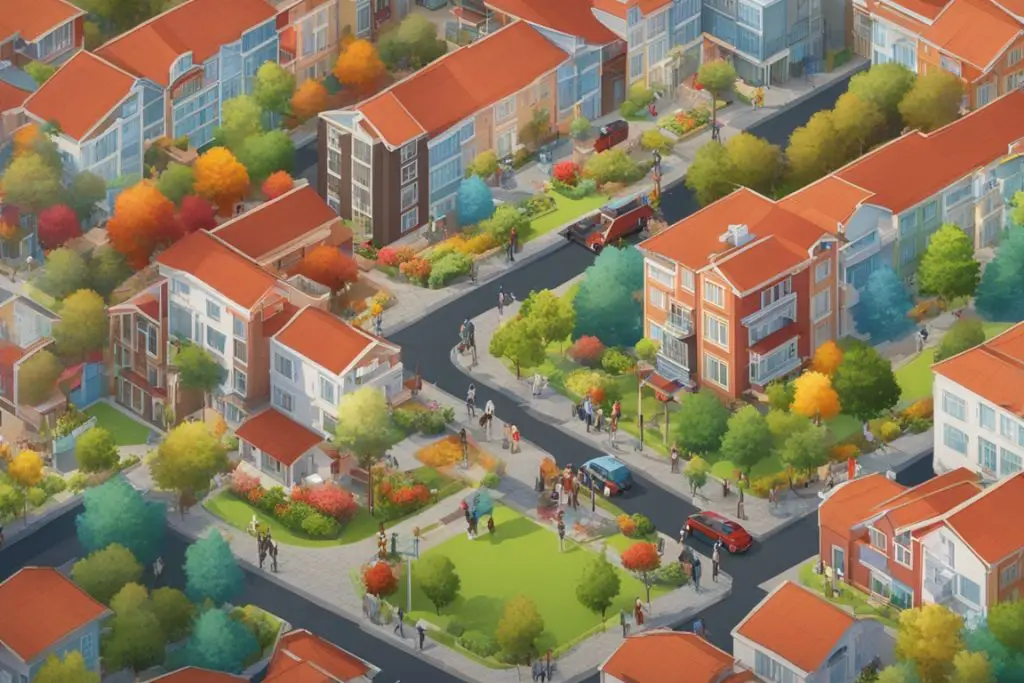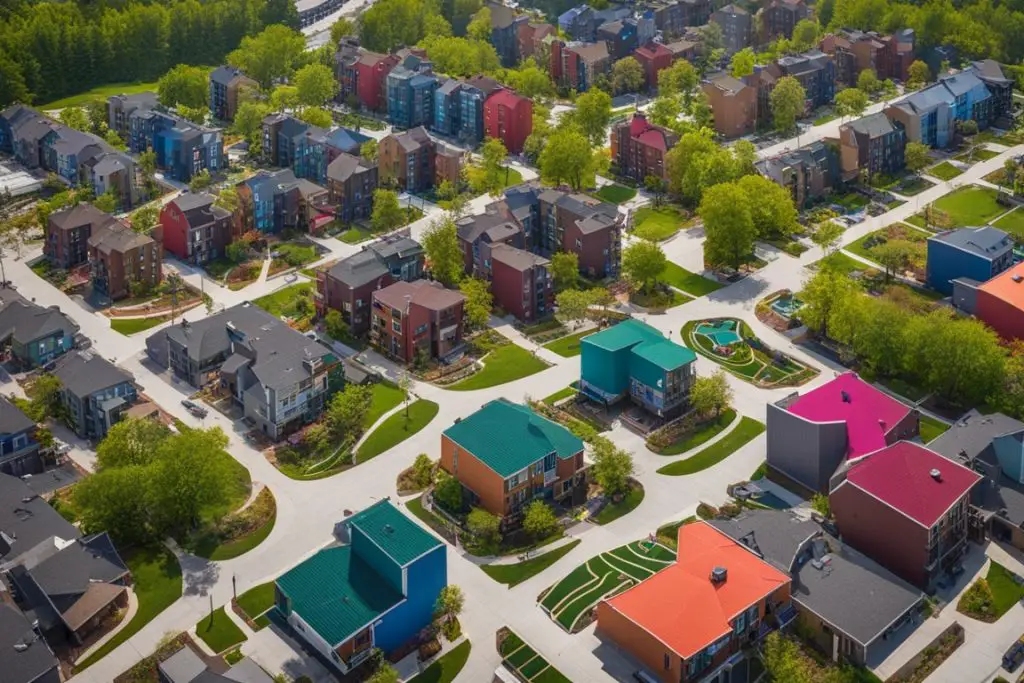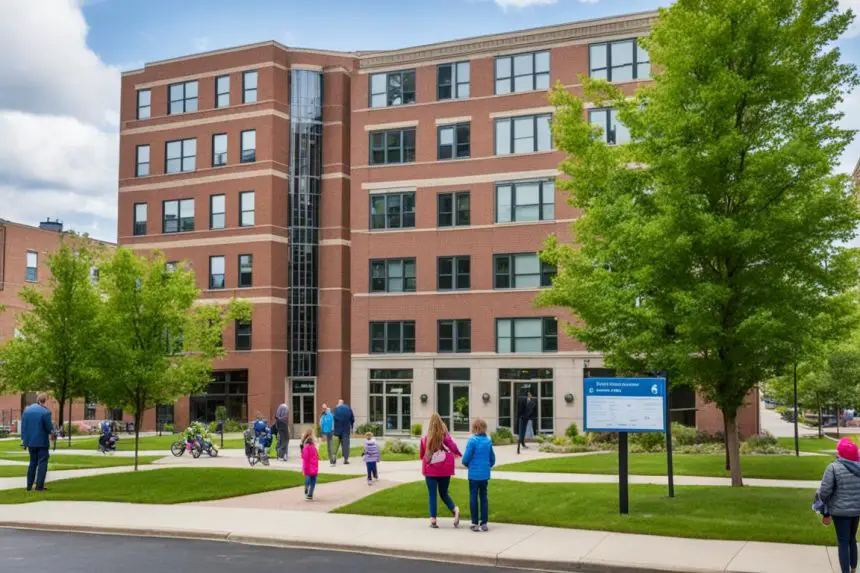Did you know the Housing Choice Voucher program helps over 2.3 million households in the U.S1.? This year marks 50 years since the Housing and Community Development Act of 1974 was passed. It’s a big deal because programs like the Housing Choice Voucher, Project-Based Rental Assistance, and Community Development Block Grants have made a huge difference. They’ve helped millions get access to homes they can afford1.
The Biden-Harris team is putting more money into HUD programs than we’ve seen in 20 years1. This includes 70,000 emergency vouchers and 20,000 new ones. Their goal? To make housing less expensive and easier to get. HUD’s Acting Secretary, Adrianne Todman, is working hard to keep improving these programs. They’re tackling the high cost of housing directly.
If you’re on the hunt for an affordable place to live or need help from the government for housing, this info is key1. The President’s budget proposal for 2025 plans to give $32.8 billion to the Housing Choice Voucher Program. Plus, there’s $7.5 billion set aside for new project-based help. With housing being a big concern for many, now’s the time to see what HUD can do for you.
Key Takeaways
- The Housing Choice Voucher program supports over 2.3 million households1.
- The Project-Based Rental Assistance program aids more than 1.3 million households1.
- Over $100 billion has been spent through CDBG-Disaster Recovery to help communities recover after natural disasters1.
- The Biden-Harris Administration has expanded the HCVP with 70,000 Emergency Housing Vouchers and 20,000 new fair share vouchers1.
- HUD’s 2025 Budget proposal includes $32.8 billion for the Housing Choice Voucher Program and $7.5 billion for new project-based rental assistance1.
Understanding HUD Assistance Programs
The Department of Housing and Urban Development (HUD) plays a big part in housing support and rental help across the U.S. It aims to help low-income families, those at risk, and communities in need through various programs.
Housing Choice Voucher Program (Section 8)
Often called Section 8 housing, this program helps very low-income families, seniors, and people with disabilities. They get housing vouchers to make rent more affordable. Now, over 2.3 million households are part of this, showing how vital HUD’s help is for them2.
Project-Based Rental Assistance
Project-Based Rental Assistance is another key part of HUD’s efforts. It partners with private developers to provide homes for very low-income households. More than 1.3 million households have found homes this way, showing its impact2. HUD works with these developers to ensure there are enough rental units for those in need.
Community Development Block Grants (CDBG)
The CDBG program is crucial, helping over 1,000 communities improve housing and infrastructure. Since it started, more than $95 billion has been given to projects2. This money goes to fixing houses, improving infrastructure, and other development work. Today, 838 cities and 153 counties get direct grants from this program3. It focuses on reducing economic gaps, enhancing community development, and offering rental help for low-income families.
HUD’s work includes giving out housing vouchers and aiding rental programs. These steps ensure millions of Americans have a stable place to live. They lead to stronger, more welcoming communities.
Eligibility and Application Process for HUD Assistance
Knowing how to apply for HUD housing aid is key if you need low-income help. HUD supports nearly 970,000 families in public homes, with around 3,300 HAs managing them4. There are important factors that decide if you can get HUD help, listed below.
Eligibility Criteria
Each year, HUD updates the earning limits to get federal rent help5. These limits are capped at 80% of the median income for “low-income” and 50% for “very low-income” groups4. The limits change depending on where you live, how many are in your family, and the aid type5.
To figure your rent, they look at your family’s yearly earnings and deductions4.
You also need to share social security and work ID numbers as per 24 CFR 5.2165. Noncitizens have extra rules for getting aid, seen in 24 CFR subpart E5.
How to Apply
After checking if you qualify, find a local HUD-approved HA. They’ll help with your application and tell you if you’re eligible5. They regularly check if your family still qualifies, at least once a year4.
You’ll need to fill out forms about your earnings, family, and job. Having all your papers ready and correct helps avoid delays or rejections.

Common Application Pitfalls and How to Avoid Them
A big mistake is not knowing what papers you need. Make sure to have income proof, social security numbers, and family member verifications ready before you start5. Also, don’t miss the deadline for income reviews, required by HUD every 12 months4.
HAs may have priorities for those in most need of housing4. Asking about these can help get your application processed faster. And since there’s a long wait list, quickly respond to any HA messages to boost your chances of getting help.
Maximizing Your Benefits from HUD Assistance
HUD assistance can greatly improve living situations for families with low incomes. It helps them find stable and affordable housing. By using these supports wisely, families can grow economically.
HUD has $5.5 billion to help 1,200 communities6. This money supports over 2,400 grants. Acting Secretary Adrianne Todman says these grants boost local economies and help families find stable housing.
The Mark-Up-to-Market program lets owners raise rents but keep them affordable6. This makes sure they earn steady money. Section 8 contracts offer 20 years of stability6.
HUD assistance includes help for renters, homeowners, and the homeless, builds homes, and strengthens communities.
Rapid Rehousing helps those hit by COVID-19 or homelessness get back on their feet7. It offers different services to meet their needs. Certain places, like All Chicago, use extra funding to assist even more households7.

Project-Based Rental Assistance ensures families with low incomes have long-term housing support. These programs significantly improve living conditions and offer many opportunities.
The 1996 welfare reform act changed how welfare works, focusing on work and setting time limits8. This act, along with the Public Housing Reform Act, shows how housing and welfare agencies work together8.
To get the most out of HUD, know about all the available programs. RRH suggests plans based on what you’re good at, what you earn, and what assistance you can get, like SSI/SSDI or SNAP7. Working with others, like job services or schools, can help too7.
There’s also Mark-Up-to-Budget, helping non-profits buy and repair homes6. They can adjust rents to cover costs, as long as prices are fair6.
Increasing income and getting benefits can make housing stable and boost economic strength. Programs like WIOA and Social Security’s Ticket to Work can really help7.
Conclusion
Working on the crossroads of housing and health needs strong action. Using HUD’s help can greatly boost community housing efforts and health. Programs like the Housing Choice Voucher Program and Community Development Block Grants offer public housing benefits for better living conditions.
Positive outcomes from housing help include more income and transitioning to homes without subsidies. However, negative results can lead to tough situations, including homelessness in 25% of cases within a year9. The effort to build 2 million homes using HOME funding supports low-income families10. Also, making rules simpler helps communities and nonprofits do more10.
HUD’s programs do more than offer housing—they help create stronger, healthier communities. Getting involved and sharing your thoughts on fund use is important. It ensures local housing needs are met. To learn more about the link between affordable housing and health, read this detailed review9. By engaging with these resources, you help improve housing and health for you and others.
FAQ
What is the Housing Choice Voucher Program (Section 8)?
The Housing Choice Voucher Program, also called Section 8, aids low-income families. They can pick and rent homes from private owners. Over 2.3 million households get help, making their housing costs lower.
How does Project-Based Rental Assistance work?
Project-Based Rental Assistance teams up with developers for low-income family housing. It supports over 1.3 million households. They get stable, less costly places to live.
What are Community Development Block Grants (CDBG) used for?
Community Development Block Grants help over 1,000 places better their neighborhoods. They focus on fixing houses and improving public spaces. This makes areas nicer and stronger.
Who is eligible for HUD assistance programs?
HUD help goes to low-income families, older people, and those with disabilities. You need to meet certain income and living rules. Each program has its own needs for help.
How can I apply for HUD assistance?
To apply, talk to your local housing agency or check the HUD site. You need documents like income proof and your residency. It’s important to have all the needed papers ready.
What common pitfalls should I avoid when applying for HUD assistance?
Some mistakes are missing papers, not fitting the rules, and unfinished forms. Make sure you have everything, check if you qualify, and fill out forms carefully.
How can I maximize the benefits of HUD assistance?
Know about all the HUD programs and how they fit your needs. Use housing vouchers and go to homeownership classes. Keep up with new help programs. Getting in touch with housing officials and groups helps too.
Source Links
- HUD Celebrates 50 Years of Investing in Communities, Helping Families Access Affordable Housing, and Ensuring Safe and Affordable Manufactured Homes – https://www.hud.gov/press/press_releases_media_advisories/HUD_No_24_213
- Q and A about HUD – https://www.hud.gov/about/qaintro
- Programs of HUD – https://www.hud.gov/hudprograms
- HUD’s Public Housing Program – https://www.hud.gov/topics/rental_assistance/phprog
- Microsoft Word – Chapter_3_Chg 3 JUN 09 B – https://www.hud.gov/sites/documents/DOC_35645.PDF
- HUD-Multifamily-Affordable-Housing-Preservation-Clinics-How-to-Maximize-Your-Section-8-Portland-2015-07-17 – https://files.hudexchange.info/course-content/hud-multifamily-affordable-housing-preservation-clinics/HUD-Multifamily-Affordable-Housing-Preservation-Clinics-How-to-Maximize-Your-Section-8-Portland-2015-07-17.pdf
- COVID-19 Homeless System Response: Maximizing Income for Rapid Rehousing Participants During COVID-19 – https://files.hudexchange.info/resources/documents/COVID-19-Homeless-System-Response-Maximizing-Income-for-Rapid-Rehousing-Participants-During-COVID-19.pdf
- 2000-11_… – https://www.hud.gov/sites/documents/DOC_11291.PDF
- Exiting HUD Housing Assistance: Insights from the HUD HEARS Study – https://www.navigatehousing.com/hud-hears-housing-assistance-exits-study/
- HUD Modernizes Country’s Largest Affordable Housing Grant Program, Making Housing More Accessible for Families Nationwide – https://www.hud.gov/press/press_releases_media_advisories/hud_no_24_114




